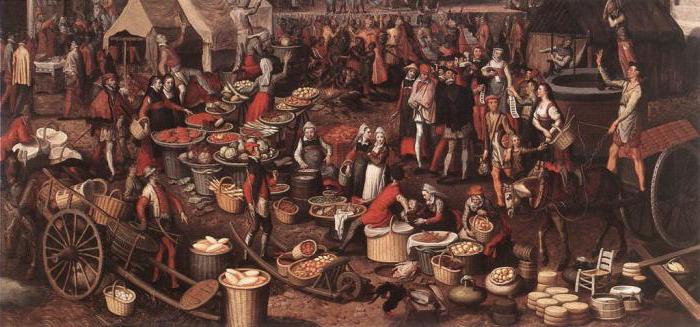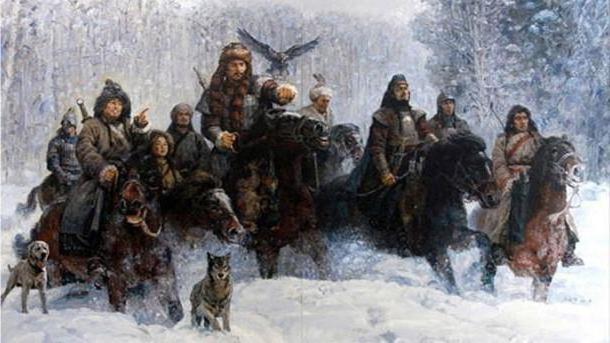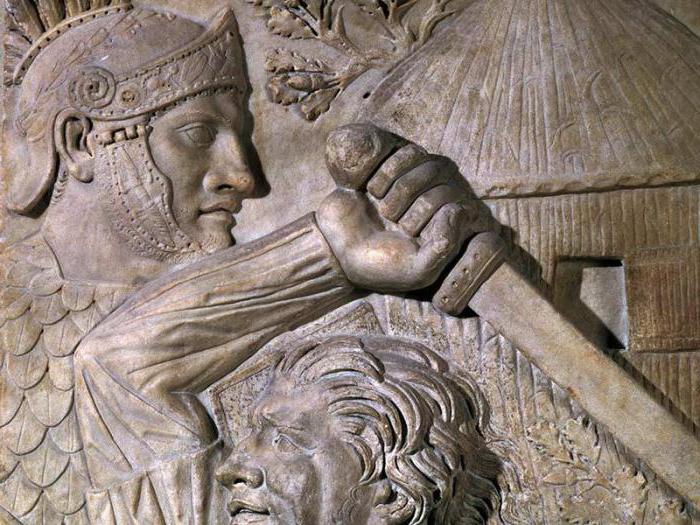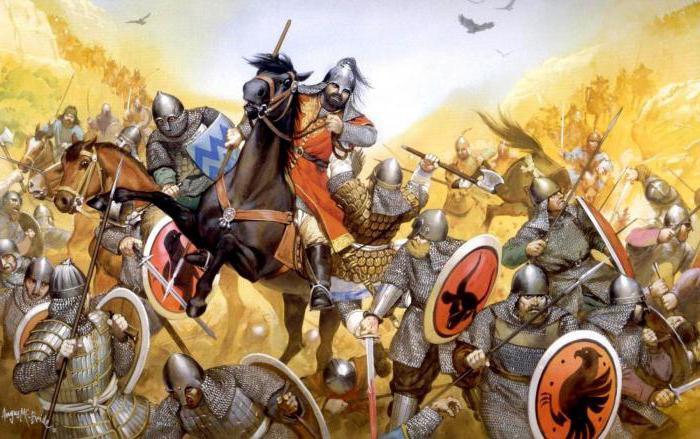In the ancient world, those who did not speak Greek or Latin were called barbarians. Under certain circumstances, barbarian tribes settled the lands of Europe and began to form new medieval states.
Age of Great Migration
The great migration of peoples and the numerous wars that occurred due to the split of the states that existed in medieval Europe led to the formation of barbarian kingdoms . Massive migrations of barbarian peoples began in the second century AD. The Roman Empire was attacked by Germanic tribes. For a century, the Romans successfully repelled the attacks of the barbarians. The situation changed dramatically in the year 378 during the battle of Adrianople between the Romans and the Goths. In this battle, the Roman Empire was defeated, thus showing the whole world that the great empire is no longer invincible. Many historians believe that it was this battle that changed the balance of power in Europe and marked the beginning of the collapse of the empire.

The second stage of resettlement, even more difficult for the Romans, was the invasion of Asians. The fragmented Roman Empire could not infinitely restrain the massive attacks of the Huns. As a result of such difficult trials in 476, the Western Roman Empire ceased to exist. The third stage is the migration of Slavic tribes from Asia and Siberia to the southeast.
In the history of the Middle Ages, the formation of barbarian kingdoms takes a rather long period of time. This era lasted five centuries, ending in the seventh century with the settlement of Slavs in Byzantium.
Reasons for Relocation
Significant natural and political factors led to the resettlement and formation of barbarian kingdoms. A summary of these factors is presented below:
1. One of the reasons was named by the historian Jordan. The Scandinavian Goths, led by King Filimer, were forced to leave their lands due to the overpopulation of the occupied territory.
2. The second reason was climatic. A sharp cooling was caused by the climatic pessimum. Humidity has increased, air temperature has dropped. It is understandable that the northern peoples suffered the most from the cold snap. Agriculture was in decline, forests gave way to glaciers, transport routes became impassable, and mortality increased. In this regard, the inhabitants of the North migrated to warmer regions, which subsequently led to the formation of barbarian kingdoms in Europe.
3. At the beginning of the mass resettlement, the human factor played an important role. Society self-organized, tribes united or quarreled among themselves, tried to confirm their power and power. This led to the pursuit of conquest.
Huns
The Huns, or Huns, were called the steppe tribes that inhabited the northern part of Asia. The Huns formed a fairly powerful power. Their eternal adversaries were their Chinese neighbors. It was the confrontation between China and the Hunnish state that caused the construction of the Great Wall of China. In addition, it was with the movement of these tribes that the second stage of the migration of peoples began.

The Huns suffered a crushing defeat in the struggle with China, this forced them to look for new places to live. The Hun movement created a "domino effect." Having settled on new lands, the Huns drove out the indigenous inhabitants, and they, in turn, were forced to look for a home in another place. The Huns, gradually spreading in a westerly direction, initially displaced the Alans. Then the Goth tribe stood in their way , who, unable to withstand the onslaught, divided into Western and Eastern Goths. Thus, by the fourth century, the Huns came close to the walls of the Roman Empire.
At sunset of the Roman Empire
In the fourth century, the great Roman Empire was going through hard times. To make the management of a huge state more constructive, the empire was divided into two parts:
- Eastern - with the capital Constantinople;
- Western - the capital remained in Rome.
Many tribes fled from the constant attacks of the Huns. The Visigoths (Western Goths) initially sought refuge in the territory of the Roman Empire. However, later the tribe revolted. In 410, they captured Rome, causing significant damage to the western part of the country, and moved to the lands of Gaul.

The barbarians were so firmly entrenched in the empire that even the Roman army for the most part consisted precisely of them. And the leaders of the tribes were considered governors of the emperor. One of these governors overthrew the emperor of the western part of the state and took his place. Formally, the ruler of the western territories was the eastern emperor, but in fact the power belonged to the leaders of the barbarian tribes. In 476, the Western Roman Empire finally ceased to exist. This was a crucial moment in the history of the formation of barbarian kingdoms. Having briefly studied this segment of history, you can see a clear line between the creation of new states of the Middle Ages and the collapse of the ancient world.
Visigoths
At the end of the third century, the Visigoths were federates of the Romans. However, between them there were constant armed clashes. In 369, a peace treaty was signed, according to which the Roman Empire recognized the independence of the Visigoths, and the Danube began to separate them from the barbarians.
After the Huns attacked the tribe, the Visigoths sought refuge from the Romans, and they allocated the lands of Thrace for them. After many years of confrontation between the Romans and the Goths, the following relations developed: the Visigoths were separate from the Roman Empire, did not submit to its system, did not pay taxes, and in return they substantially replenished the ranks of the Roman army.
Through a long struggle every year the Visigoths obtained more and more comfortable conditions for their existence in the Empire. Naturally, this fact gave rise to discontent in the Roman ruling elite. Another aggravation of relations ended with the capture of Rome by the Visigoths in 410. Over the following years, the barbarians continued to act as federates. Their main goal was to capture the maximum amount of land that they received, fighting on the side of the Romans.
The date of the formation of the barbarian kingdom of the Visigoths is 418, although for the next several years they remained federates of the Romans. The Visigoths occupied the territory of Aquitaine on the Iberian Peninsula. Theodoric the First, elected in 419, became the first king. The state existed for exactly three hundred years and became the first formation of barbarian kingdoms in history.
The Visigoths proclaimed their independence from the Empire only in 475 during the rule of Eirich, the son of Theodorich. By the end of the fifth century, the territory of the state increased by six times.
Throughout its existence, the Visigoths fought with other barbarian kingdoms formed on the ruins of the Roman Empire. The most fierce struggle was with the Franks. In the confrontation with them, the Visigoths lost a significant part of their territories.
The conquest and destruction of the kingdom took place in 710, when the Visigoths could not withstand the onslaught of the Arabs in their desire to capture the Iberian Peninsula.
Vandals and Alans
The formation of the barbarian kingdom of the Vandals and Alans took place twenty years after the creation of the state by the Visigoths. The kingdom occupied a fairly large plot in the north of the African continent. In the era of the great migration, the vandals arrived from the Danube plains and settled in Gaul, and then they, together with the Alans, occupied Spain. From the Iberian Peninsula they were driven out by the Visigoths in 429.
Having occupied an impressive part of the African possessions of the Roman Empire, the Vandals and Alans had to constantly repel the attacks of the Romans who wanted to return theirs. However, the barbarians also raided the Empire and continued to conquer new lands in Africa. Vandals became the only other barbarian peoples who had their own fleet. This greatly enhanced their ability to resist the Romans and other tribes encroaching on their territory.
In 533, the war with Byzantium began. It lasted almost a year and ended in the defeat of the barbarians. Thus, the Kingdom of Vandal ceased to exist.
Burgundy
The Kingdom of the Burgundians occupied the left bank of the Rhine River. In 435, they were attacked by the Huns, killing their king and plundering houses. The Burgundians had to leave their homes and move to the banks of the Rhone.
The Burgundians occupied the territory at the foot of the Alps, which currently belongs to France. The kingdom suffered strife, the pretenders to the throne brutally killed their opponents. Gundobad played the largest role in rallying the kingdom. Killing his brothers and becoming the sole contender for the throne, he published the first set of laws of Burgundy - “Burgundy Truth”.
The sixth century was marked by a war between the Burgundians and the Franks. As a result of the confrontation, Burgundy was conquered and annexed to the state of the Franks. The formation of the barbarian kingdom of the Burgundians dates back to 413 year. Thus, the kingdom lasted a little over a hundred years.
Ostrogoths
The formation of the barbarian kingdom of the Ostrogoths began in 489. It lasted only sixty-six years. They were Roman federates and, being independent, maintained the imperial political system. The state occupied the territory of modern Sicily, Italy, Provence and the Pre-Alpine region, the capital was Ravenna. The kingdom was conquered by Byzantium in 555.
Franks
During the formation of barbarian kingdoms, the kingdom of the Franks, having begun its history in the third century, became politically significant only in the thirties of the next century. Francia has become the most significant and strong among other states. Franks were numerous and included several formations of barbarian kingdoms. The Kingdom of the Franks became one during the reign of King Clovis the First of the Merovingian Dynasty, although the state was subsequently divided between his sons. He was one of the few rulers to adopt Catholicism. He also managed to significantly expand the possession of the state, defeating the Romans, Visigoths and Bretons. His sons annexed to Thrace the lands of the Burgundians, Saxons, Frisians and Thuringians.

By the end of the seventh century, the nobility acquired considerable power and, in fact, ruled Thrace. This led to the decline of the Merovingian dynasty. The beginning of the next century was marked by civil war. In 718, Karl from the Carolingian dynasty came to power. This ruler strengthened the position of Francia in Europe, which greatly weakened during the civil strife. The next ruler was his son Pipin, who laid the foundation for the foundation of the modern Vatican.
By the end of the first millennium, Thrace was divided into three states: West Frankish, Middle and East Frankish.
Anglo-Saxons
Anglo-Saxons settled in the British Isles. Heptarchy - the so-called period of the formation of barbarian kingdoms in Britain. There were only seven states. They began to form in the sixth century.
The West Saxons formed Wessex, the South - Sussex, the East - Essex. The Angles formed East Anglia, Northumbria, and Mercia. The Kingdom of Kent belonged to the Utahs. Only in the ninth century did Wessex manage to unite the inhabitants of the British Isles. The new single state was called England.
The resettlement of the Slavs
In the era of the formation of barbarian kingdoms, the resettlement of Slavic tribes took place. The migration of the Pre-Slavs began a little later than the Germanic tribes. The Slavs occupied a vast territory from the Baltic to the Dnieper and to the Mediterranean Sea. It should be noted that it was during this time period in the historical chronicles that the Slavs were first mentioned.
Initially, the Slavs occupied the territory from the Baltic to the Carpathians. However, over time, their possessions expanded significantly. Until the fourth century they were allies of the Germans, but then they began to fight on the side of the Huns. This was one of the decisive factors in the victory of the Huns over the Goths.
The movement of Germanic tribes made it possible for the Slavic tribes to occupy the territory of the Lower Dniester and the middle Dnieper. Then they began to move towards the Danube and the Black Sea. Since the beginning of the sixth century, a series of raids by Slavic tribes in the Balkans has been noted. The Danube has become an unofficial border of Slavic lands.
Significance in world history
The consequences of the great migration of peoples are very mixed. On the one hand, some tribes ceased to exist. On the other hand, the formation of barbarian kingdoms took place. States fought among themselves, but also collaborated and united in alliances. They exchanged skills and experience. These associations became the progenitors of modern European states, laying the foundations of statehood and legality. The main consequence of the formation of barbarian states was the end of the Ancient World and the beginning of the Middle Ages.